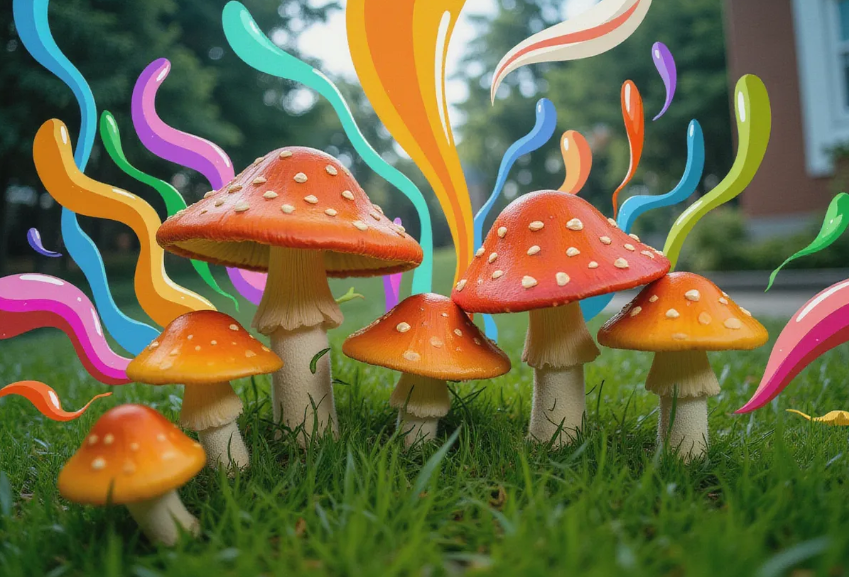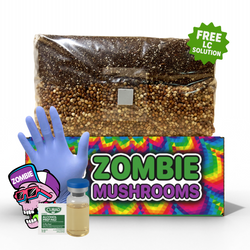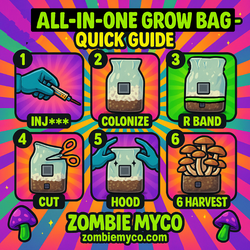⬇️ Prefer to listen instead? ⬇️
- Studies show outdoor mushroom beds can do better than indoor setups when you compare cost to how much you get (Thomas et al., 2018).
- A single 4x10 ft Wine Cap mushroom bed can make over 100 lbs each year if things are just right (Stamets, 2005).
- Growing mushrooms outdoors helps soil health by making the tiny life in it more varied.
- It takes less than a day to build an outdoor mushroom bed, and you only need basic, cheap stuff.
- Picking a spot that's shady and damp is key to growing mushrooms well outdoors.
If you have a shady corner and some tools, you can grow fancy mushrooms at home. You don't need an indoor setup or grow lights. Outdoor mushroom beds make it simple to grow mushrooms in a way that helps the environment, and using grain spawn bags can make the process even easier and more productive.
You use less stuff, and it's more flexible. If you're new to growing mushrooms or want to do more than indoor kits, growing outdoors lets you get lots of mushrooms without much work.
Why Grow Mushrooms Outdoors?
Growing mushrooms outdoors is one of the most rewarding and low cost mushroom cultivation methods available. Instead of pricey grow rooms or high-tech gear, an outdoor mushroom bed lets you transform your garden into a natural fruiting ground with minimal effort. Using organic matter like wood chips or straw, you can support sustainable harvests of gourmet species.

There are many good things about growing mushrooms outdoors for the environment, money, and nature.
-
Low Cost Mushroom Cultivation: Outdoor beds rely on natural shade, rainfall, and inexpensive substrates like straw or wood chips—making it one of the most affordable methods.
-
Eco-Friendly & Sustainable: Instead of energy-intensive equipment, you’re working with natural cycles that enrich soil health and recycle organic matter.
-
Simple Maintenance: Unlike indoor setups that need constant adjustments, outdoor beds often thrive with just occasional watering and mulching.
-
Impressive Yields: With the right conditions, outdoor beds can produce heavy flushes of mushrooms season after season.
For anyone interested in growing mushrooms outdoors, it’s one of the best ways to combine sustainability, affordability, and productivity.

What Is a Mushroom Bed?
An outdoor mushroom bed is a space where you put plant stuff that breaks down (substrate). Mushroom spawn (mycelium) grows on it. This is like forests where fallen trees and leaves give food and cover for wild mushrooms.
A mushroom bed has a few main parts
- Spawn: This is the living mushroom culture that you put in the bed. It can be sawdust, grain, or plug spawn.
- Substrate: This is what the mycelium eats. For outdoor beds, substrate is often wood chips, straw, sawdust, cardboard, or hardwood mulch.
- Microlocation: This is a spot you pick that's cool, shady, and stays somewhat damp.
Think of a mushroom bed like a compost pile made to grow mushrooms instead of just breaking down waste.
How to Choose the Right Spot for Your Outdoor Mushroom Bed
Mushrooms can be picky about where they grow. Picking the right spot is key to making a mushroom bed that grows well and makes lots of mushrooms. Here’s a close look at what to think about:

Shade and Sun Protection
Mushrooms do best in places like a forest floor. They need shade and protection from direct sun. Spots under trees that lose leaves in winter are great. They give full shade in summer and some light in spring and fall.
Good spots
- North sides of buildings
- Under thick bushes or trees
- Under decks or roofs that stick out
Consistent Moisture Levels
Mycelium needs water to spread and live. Low spots in your yard that collect water but don’t get too wet are good. Ground that feels damp or soft is great, mostly if it gets a bit misty in the morning or stays humid all day.
Don’t use
- Spots that dry out fast
- Open spots in full sun
- Spots that don't drain well and get waterlogged
Good Drainage
Water is needed, but too much water will sit and rot the bed. This can bring in mold or bad bacteria. A good test is to dig a little hole. If water stays in the hole after 5–10 minutes, it might not drain well enough.
How to make it better
- Make beds a little higher like a raised mound
- Use a base layer that drains well, like big wood chips
- Put sand or gravel under the cardboard to help water run off
Airflow and Wind Protection
A little air moving around stops mold and keeps the bed from drying out. Put beds near things like fences, trees, or bushes that block strong winds.
Best Mushroom Varieties for Outdoor Beds
Not all fungi adapt equally well to an outdoor mushroom bed, but a few varieties stand out as reliable choices:
Wine Cap (Stropharia rugosoannulata)
Known as the “garden giant,” this species thrives in wood chips, makes great compost partners, and delivers large, meaty mushrooms.
- Best Substrate: Wood chips, straw
- Harvest Time: Late spring to fall
- Yield Possible: Over 100 lbs per 4x10 ft bed each year (Stamets, 2005)
Blue-Grey Oyster (Pleurotus ostreatus)
Fast-colonizing and hardy, oysters love straw and wood substrates, making them perfect for low cost mushroom cultivation.
- Best Substrate: Straw, wood sawdust
- Harvest Time: Spring to fall
- Growth Speed: Grows fast (2–4 weeks)
Yellow-Gold Oyster (Pleurotus citrinopileatus)
Adds color to your garden bed with its bright clusters, while performing well in warmer climates.
- Best Substrate: Straw, wood chips
- Harvest Time: Late spring to early fall
- Special Note: Pretty gold caps look good in cooking
Lion’s Mane (Hericium erinaceus)
A gourmet mushroom that grows surprisingly well outdoors on hardwood chips, offering unique texture and digestive health benefits.
- Best Substrate: Hardwood logs or sawdust with extra stuff
- Harvest Time: Late summer to fall
- Cooking Use: Tastes like seafood, often used for health reasons

How to Build a Mushroom Bed (Step-by-Step Guide)
Making an outdoor mushroom bed is easier than you might think. You can have a bed ready to grow mushrooms in less than a day.
Supplies
- Mushroom spawn (Zombie Mushrooms has easy kits for beginners)
- Organic substrate: straw, wood chips, cardboard, or sawdust
- Basic garden tools: shovel, rake, hose or watering can
- Optional: mulch like leaves or forest stuff for the top
Instructions
- Pick the Spot - Choose a shady, cool spot that stays damp but doesn’t get waterlogged.
- Clear the Spot - Remove grass, weeds, or trash so the spawn touches the substrate better.
- Make a Base Layer - Put down cardboard or newspaper to stop weeds and give the mycelium food to start.
- Layer Substrate and Spawn (“Lasagna Method”) - Put layers of substrate and mushroom spawn, about 3–5 inches of substrate for each spawn layer.
- Wet the Bed - Wet each layer as you build. Make sure it's damp, not soaked.
- Mulch the Top - Put a last layer (1–2 inches) of straw, leaves, or bark chips on top to keep it warm and hold in water.
- Water Often - Spray water on top when needed, mostly in the first weeks while it’s starting to grow.

Outdoor Mushroom Bed Maintenance
Taking care of your mushroom bed is simpler than most garden projects but still requires attention:
-
Moisture Control: Beds should stay damp but not waterlogged. In dry spells, add supplemental watering to keep the mycelium alive.
-
Mulching: A fresh layer of straw or wood chips every few months helps retain moisture and extends the life of the bed.
-
Pest Prevention: Slugs and insects may appear; simple barriers or raised beds reduce this risk.
-
Long-Term Productivity: With proper care, an outdoor mushroom bed can produce mushrooms for 2–3 years before needing full refreshment.
Following these basic outdoor mushroom bed maintenance steps ensures reliable harvests with minimal ongoing effort.

How & When to Harvest
Knowing when mushrooms are ready is key to picking them when they taste best
- Blue-Grey and Yellow Oysters: Pick when the caps start to turn up but before they drop spores.
- Wine Caps: Best picked right after the caps open fully, while the gills are still closed.
- Lion’s Mane: Pick when the spines are about 1/2 inch long and before they turn yellow.
Use clean scissors or gently twist and pull. Be careful not to hurt the mycelium around it. It can make more mushrooms later.

Common Issues and Troubleshooting
Mushroom beds can have some problems
- No Growth: Often because the substrate is too dry, not enough spawn compared to substrate, or a bad spot.
- Mold Problems: From too much water and not enough air. Make drainage better and space things out more.
- Pests: Slugs and rodents often cause trouble. Lift beds up or use copper tape or nets.
- Weeds Taking Over: Make sure to keep your cardboard base and put new mulch on each year.

Starter Kits for Outdoor Mushroom Cultivation
Start your growing with easy kits from Zombie Mushrooms
- Lion’s Mane Kit – Great for growing on logs and shady raised beds
- Blue-Grey Oyster Kit – Fast and reliable, lots of mushrooms
- Yellow-Gold Oyster – Best for gardeners in warm places with shade
- 2-Kit Bundle – Grow two types and see what happens in your backyard mushroom lab

Why Choose Zombie Mushrooms for Your Spawn?
Zombie Mushrooms gives you great spawn that’s checked to grow well outdoors
- Live, working cultures for faster growth
- Tested in a lab and clean of bad stuff
- Easy steps with help from experts
- Deals on bundles to try different kinds without spending too much
FAQ
-
What is the cheapest way to grow mushrooms outdoors?
Creating an outdoor mushroom bed with wood chips or straw is among the most affordable options for beginners. -
Which mushrooms grow best in outdoor beds?
Wine Cap, Oyster varieties, and Lion’s Mane are the best mushroom varieties for beds due to their adaptability. -
How long does it take for an outdoor mushroom bed to produce?
Most beds colonize in 4–8 weeks and can fruit by the next season, depending on temperature and moisture. -
Do outdoor beds need daily maintenance?
No—basic outdoor mushroom bed maintenance like watering during dry spells and adding mulch a few times a year is usually enough. -
Can I start mushrooms indoors before moving them outside?
Yes, starting with mushroom grow bags indoors is a great way to build strong mycelium before transferring spawn outdoors.
Is a Mushroom Bed Worth It?
Yes, for sure. With little money and some planning, an outdoor mushroom bed can give you fresh, fancy mushrooms each season. And it helps your soil, uses less yard waste, and makes your yard more alive.
For less than eating out once, you can make a good, lasting mushroom garden that gives you food for years. It’s a real way to be more self-sufficient, care for nature, and have tasty food from your yard. Try a kit today and see how fun growing mushrooms outdoors can be.
Citations
- Stamets, P. (2005). Mycelium Running: How Mushrooms Can Help Save the World. Ten Speed Press.
- Thomas, R., Chang, S. T., & Miles, P. G. (2018). Mushroom growing for a world that lasts. International Journal of Agricultural Sustainability, 16(1), 84–96.



